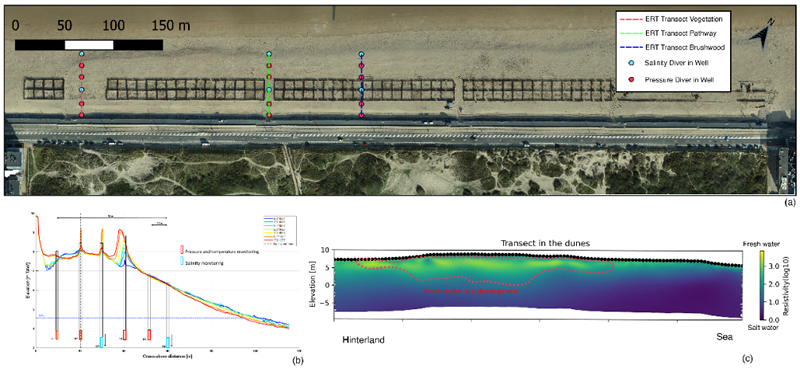J. Beerlandt1,2*, P. Rauwoens1
1Hydraulics and Geotechnics, Department of Civil Engineering, KU Leuven; 2 Research Foundation Flanders 1SG3423N
*Corresponding author:
Introduction
Freshwater lenses beneath the Belgian dunes play a crucial role in protecting the hinterland from saltwater intrusion. However, urbanization and other human activities have led to a decline in their formation and preservation, putting freshwater storage and the economy at risk. To address this issue, gaining a deeper understanding of the hydrogeological feedback mechanisms during dune development is crucial, especially in the case of nature-based solutions such as artificial dunes. The project aims to fill a knowledge gap in existing research by investigating the hydrogeological feedback mechanisms involved in dune development and designing a hydrogeological model to predict freshwater lens growth in dynamic artificial dune environments.
Methods
To better understand and model freshwater lens development, an artificial dune area of 750 x 20 m2 has been constructed in Raversijde, Belgium. Vegetation has been planted with varying spatial distributions and planting densities, some surrounded by brushwood fences with different densities. The project will use a combination of field measurements, data analysis, and numerical modelling. Regular ERT measurements will be conducted to visualize subsurface resistivity (salinity) and monitor the development of the freshwater lens. The water table, tidal response, salt levels, and topographical changes will be monitored. Drone surveys will be conducted to monitor topographical changes, and RTK measurements will be taken before and after storm conditions to understand the effects of storm surges on groundwater variations and salinity. The dataset generated from the analysis of these measurements, combined with information from nearby monitoring wells, a weather station, and an artificial dike, will be used to create and validate a hydrogeological SEAWAT model simulating the development of the freshwater lens, mixing process of saline and freshwater recharge, and maximum storage of fresh groundwater.
Results
The results of this study will have a significant impact on coastal management and the preservation of freshwater resources. By validating the hydrogeological model through case studies along the Belgian coast, the impact of sea level rise and different scenarios of coastal management on freshwater lens development will be evaluated. This will provide valuable insights and recommendations for creating climate-resilient coastal areas. The research will also explore the potential of artificially replenishing the dune with waste or runoff water to improve freshwater lens growth. Ultimately, the results of this study will offer a valuable toolkit for effectively understanding and managing freshwater lenses in artificial dune systems.

Figure 1: (a) Experimental setup at the artificial dune site [Raversijde, Ostend] (b) Cross-section dune with placement monitoring wells (c) Inverted ERT Survey in transect dune
I. Surname1*, F.N. Another-Surname2 , Y. Next-Surname2
1 University Name, Country; 2 Organization Name, Country
* Corresponding author: mail.name@organization.org


